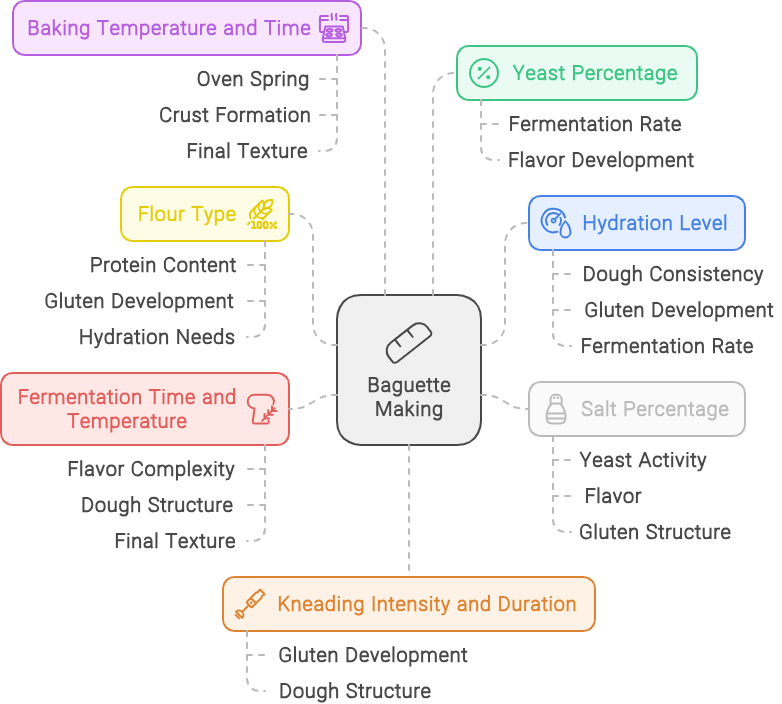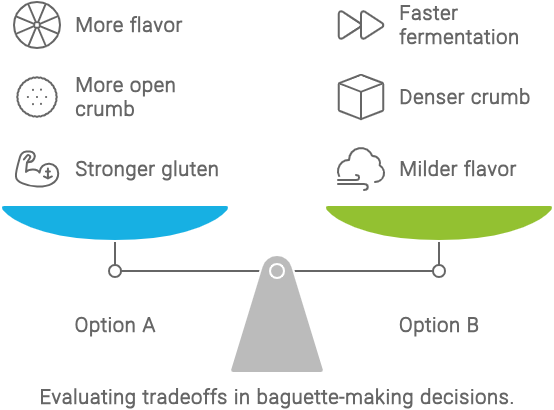A Computational Approach to Perfecting Your Baguette Recipe
Introduction
In the world of artisan bread, the perfect baguette is a quest that many bakers pursue. If you’ve ever wondered how to tweak your baguette recipe for the perfect crust, crumb, and flavor, you’re in the right place. With a bit of computational thinking, we can break down the process and provide a structured way to experiment with your recipe, just like an algorithm.
This post will guide you through the key variables in baguette baking—hydration, flour type, kneading, salt, yeast, fermentation, and baking parameters—and how each one influences your final product. Whether you’re a novice or an experienced baker, this guide will help you refine your technique and achieve the perfect baguette.


Pseudocode: Structuring Your Experimentation
For those who love a bit of structure, here’s a pseudocode outline to guide your baguette experimentation. This simple algorithm helps you systematically adjust variables, bake, evaluate, and iterate until you find your perfect baguette.
// Define Variables
flour_type = "Type 550"
water_to_flour_ratio = 0.663
kneading_time = 0
salt_percentage = 0.02
yeast_quantity = 0.015
fermentation_time = 240
baking_temperature = 250
baking_time = 25
// Experiment Function
function Experiment(flour_type, water_to_flour_ratio, kneading_time, salt_percentage, yeast_quantity, fermentation_time, baking_temperature, baking_time):
Adjust Hydration
// impacts fermentation (autolyse) time
Adjust Flour Type
// impacts how much water will be bound
Adjust Kneading Time
// no knead may not build enough chewiness
Adjust Salt Percentage
// salt enhances flavor
Adjust Yeast Quantity
// quick is simple; long is complex
Adjust Fermentation Time
// time is beneficial
Adjust Baking Parameters
// here you determine crust characteristics
Bake and Evaluate
// at the end of the day, it's just a baguette
// Iterate Until Satisfied
While experimenting:
adjust parameters
call Experiment()
Log results and adjustPractical Tips for Experimentation
Taste and Texture: Always evaluate the taste, texture, and overall feel of the baguette. The best baguette is the one that satisfies your personal preferences.
Start Simple: Begin with one variable at a time. For example, try adjusting hydration initially by iterating on a recipe in triplicate and observe how it changes your baguette. However, keep in mind that many of the factors listed above do not act independently.
Keep a Log: Document your experiments, noting down the changes made and the results. This helps you refine your technique over time.
Conclusion
Baking the perfect baguette is both an art and a science. By understanding the key variables and how they interact, you can optimize your recipe to suit your taste. Whether you prefer a crisp crust, an open crumb, or a chewy texture, this guide gives you the tools to experiment and achieve your ideal baguette.
Happy baking, and remember—every great loaf starts with a much-kneaded algorithm!

